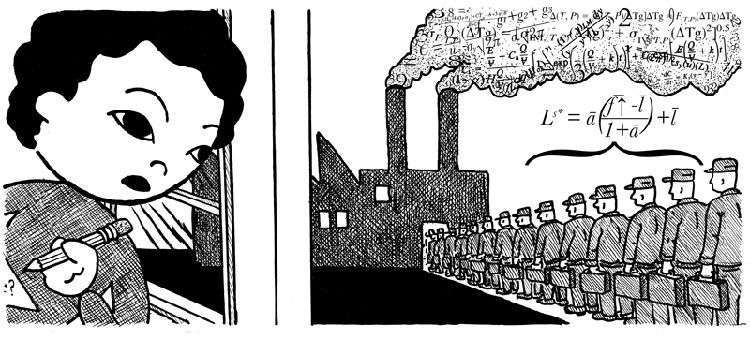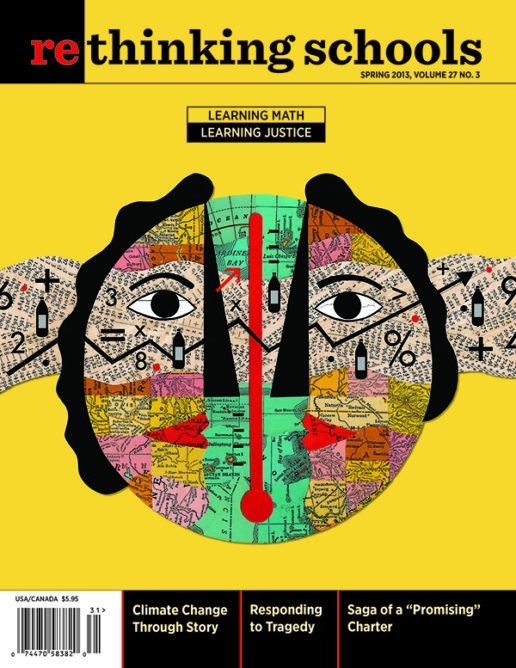Editorial: Just Math

How to best teach mathematics has been debated for decades. Recently these debates have been rekindled with the implementation of the new Common Core State Standards for mathematics. Teachers are re-examining focus, scope, and sequence of math instruction.
What’s absent in most of these discussions, however, is something more fundamental than whether patterns should be taught in kindergarten or when multiplication of fractions should be mastered.
The larger issue is how children will learn to use math to make sense of and transform the world around them. For too long, math curriculum and instruction have been shaped by corporate notions of “international competitiveness” or the demands of a labor market with high-tech jobs for a few and low-wage slots for the many. Children and youth deserve math curriculum that is different in essence from the new standards-aligned texts and tests that multinational textbook companies are scrambling to publish as they seek to corner profitable markets.
Our children deserve to be taught math in ways that help make visible the ecological, social, and community issues that will shape their lives and their futures. They need math skills that help them understand and care for the planet and each other, not wage test-score wars with children around the globe.
Students deserve to be taught math in ways that democratize the classroom. As math educator Rochelle Gutiérrez explained at the recent Creating Balance in an Unjust World math conference in San Francisco, when we teach math as an abstraction, we are teaching children to separate their minds from their bodies, their lives, and their communities. A just math curriculum has at its core issues that matter. When math is embedded in important issues—from racial disparities in school expulsions to the rate of global warming—every child has a contribution to make and a stake in the answers. This is “real-world” math, not calculations about which train gets to the station first.
This is not about political indoctrination or using curriculum for narrow purposes. All curriculum is about the construction of meaning, and all curriculum is political. To advocate for a broad social justice framing instead of a narrow technocratic one is to affirm that math is indeed for and about all of us.
There is a particular urgency to teaching math in ways that prepare students for the ecological, social, and community issues that threaten life on Earth. In a recent Rolling Stone article, “Global Warming’s Terrifying New Math,” environmental activist Bill McKibben writes, “to grasp the seriousness of our predicament, you just need to do a little math.”
McKibben proceeds to numerically reveal the climate collision course we are on. For example, in order to prevent the planet from warming a potentially catastrophic 2 degrees Celsius (about 3.6 degrees Fahrenheit), we can release no more than 565 gigatons of carbon into the atmosphere. The problem? Energy corporations—and countries that act like energy corporations (think Kuwait)—have estimated reserves of 2,795 gigatons of carbon, which they plan to sell and burn for energy. “Storying” the climate crisis with numbers allows students to see our predicament in new ways.
This issue of Rethinking Schools—which previews our new, long-awaited second edition of Rethinking Mathematics —features articles that provide examples of how math can be used so students are better prepared to understand and change the world. In “Whose Community Is This? Mathematics of Neighborhood Displacement,” Rico Gutstein, who co-edited the book with Bob Peterson, explains how he engaged students in high-level math concepts to understand the mortgage crisis and gentrification of their neighborhood. Flannery Denny shows middle school students how to manipulate percents to investigate their own “real-life” questions in “Beyond Marbles: Percent Change and Social Justice.” In Selene Gonzalez-Carillo and Martha Merson’s article, “Transparency of Water: A Workshop on Math, Water, and Justice,” questions about bottled water are the context in which children and adults learn math together. In these articles, we see students change their view of mathematics—from seeing it as a bunch of disconnected, rote rules to be memorized and regurgitated, to appreciating it as a powerful way to make sense of complex social realities.
Social justice education is not just for social studies and language arts classrooms. Every discipline offers unique ways to understand and express the world. Looking at the world through math tells a story about the world in a different way. It’s one thing to look at the social and ecological impact of climate change, for example, but mathematics gives us another way to make sense of reality. It can complement other forms of narrative and deepen our understanding of the crises.
We hope the articles in this issue and the new edition of Rethinking Mathematics inspire math teachers to weave social justice and ecological issues throughout the mathematics curriculum. But we also hope that teachers of other subjects will interject mathematics into their curricular areas. It’s an approach that can deepen students’ understanding of society and prepare them to be critical, active participants in a democracy.

